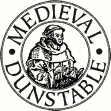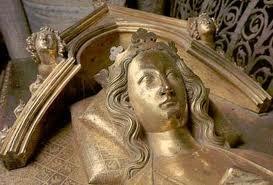
Medieval Dunstable© Webmaster Helen Mortimer Privacy Policy | Terms of Use



THE ELEANOR CROSS
Author Joan Curran
Eleanor of Castile, the much-loved wife of King Edward I, died at Harby, near Lincoln, at the end of November 1290. Her body was brought to Westminster to be buried in the Abbey and the King ordered that a memorial cross should be erected at each of the places where her body had rested on the way. The cortege reached Dunstable about December 11th and the coffin was placed before the altar of the Priory Church to rest there overnight before being taken to St. Albans the next day. While the body was here the bier was rested at the crossroads for the Chancellor and lords of the realm , assisted by the Prior, to mark the spot where the cross was to be erected.
Only three of the Eleanor crosses still survive, at Northampton, Geddington and Waltham. No picture of the Dunstable cross has been found, but from those which remain we have some idea of what it would have been like. All of them were tall, stone monuments of ‘remarkable size’ (the one at Geddington is nearly 40 feet high). Though they differed in detail they were all constructed in three tiers, decreasing in size towards the top, and surmounted with a cross. Of the three still standing one is hexagonal in form, one octagonal and one triangular, and all are elaborately carved with statues and coats of arms. They all bear the arms of England, Castile and Ponthieu, and it was said of all of them that the face of Queen Eleanor showed ‘serenity and greatness of soul’.
It was in the autumn of 1291 that the stonemasons arrived in Dunstable to begin work on the cross, which took about two years to complete. It was destroyed by Parliamentarian soldiers in 1643.
Wife of Edward 1st - Queen Eleanor's funeral cortege 5.12.1290

| Archaeology |
| Audio Guides |
| Education |
| Exhibitions |
| Events 2013 |
| Physic Garden |
| Priory History |
| Priory Churches / Lands |
| Town History |
| Virtual Tour |
| Website |
| Archaeology |
| Charters & Bylaws |
| Eleanor Cross |
| Famous People |
| The Fraternity |
| Friary |
| Guided Tours |
| History |
| Inns |
| Dunstable Treasures |
| Kingsbury |
| Middle Row |
| Royal Visits |
| Sheep & Wool Trade |
| The Town |
| Friary Archaeology |
| Bone Study |
| Friary |
| Annals Charters Valor Ecc |
| Archaeology |
| Churches and Lands |
| Guided Visits |
| Audio Guides |
| History |
| Monastic Life |
| Virtual Tour |
| The Augustinian Priory |
| The Canons Route |
| Bedfordshire |
| Buckingham |
| Derbyshire |
| Nothamptonshire |
| Hertfordshire |
| Leicestershire |
| Oxon |
| Priors |
| Annulment |
| History |
| Archives |
| Book Sales & Shop |
| Exhibitions |
| Guided Walks |
| Heritage Talks |
| Physic Gardens |
| Schools |
| Tourist Information Centre |
| Tea-room |
| Visits |
| Priory House Heritage Centre |
| Education |
| Knight |
| Search Results |